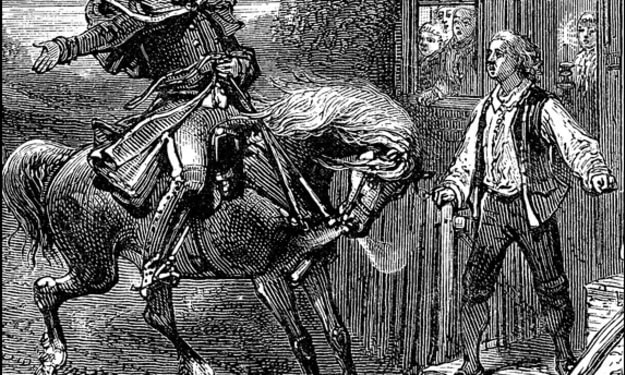Dry Scrubbing 1821
One invention can impact generations.

My name is Thomas Jennings, a lifelong free New York City resident and proud owner of one of the busiest tailor shops in Manhattan. In the late 1700s, I began a long apprenticeship that taught me the skills needed to excel in this essential craft. I’m well known throughout the elite of this city for my custom-fitted suits, shirts, and casual clothing. My little shop on Church Street is thriving. Fortunately for my clients, I’m also a curious person who enjoys solving problems.
Not a day goes by without someone asking me, “Thomas, do you know how to take this stain out of my shirt? Thomas, I spilled orange juice on my fine wool jacket. Is it salvageable?”
Removing stains from delicate fabric is difficult using existing methods. Lye soap and a metal washboard may work well for everyday garments, towels, and bedsheets, but not for custom suits and fine cloth. I need to find a solution.
My wife Elizabeth works with me during the evenings as I search for a resolution to this vexing problem. We tried letting the cloth soak in plain water for 24 hours, which did not affect the stain. We used a diluted, softer soap that showed a minimal reduction in the discoloring but didn’t remove the stain.
I spent many evenings laboring to remove this stubborn scourge when, purely by accident, a potential answer appeared. The kerosene lamp on my workbench was running low on fuel and needed replenishing. Eager to return to my research, I clumsily splashed some kerosene on a stained piece of cloth. The result was remarkable! The orange juice stain dissolved where the kerosene droplets had landed. Could this be the solution, both literally and figuratively, that Elizabeth and I had been seeking?
I discovered that kerosene removes most stains, but it has drawbacks. The smell stays in the fabric long after the liquid has evaporated. I realized that using a petroleum product was the right way to go, but I needed to find one less pungent. Our evening experiments continued.
Using various petroleum extracts and other chemicals, we discovered a mixture that consistently solved the problem. It was now time for my customers to witness the results of my magic preparation.
It didn’t take long. One of my regular customers entered the shop carrying a suit jacket I had made for him two weeks prior. He laid the article on my worktable and unfolded it. A dark red stain stretched from the middle of the right lapel to the right pocket flap. In the past, such a statin would have rendered the jacket worthless, but not today.
“Thomas,” my distraught customer pleaded, “is there anything you can do to fix this? I was at a dinner party last night, and a guest tripped, spilling her wine all over me. I like this suit and feel it’s a shame to throw it away.”
“Well, sir, this may be your lucky day! I have been experimenting with a cleaning procedure I call dry scouring. It will remove this stain and not damage the jacket. Leave it with me, and if my solution works as well as I think, your jacket will be ready for pickup tomorrow afternoon. I’m sure you’ll be happy with the results, sir.”
I closed the shop that evening and brought the jacket home. It was time to see if all our hard work was worthwhile. I soaked the jacket in my magic solution, gently scrubbing the stain and watching as it disappeared. Next, I placed the suit jacket on a drying rack and left it there overnight.
My customer entered the shop the following day, anxiously awaiting the results.
“Thomas, my good man, how did it go?”
“See for yourself, Mr. Wilson,” I said, spreading the jacket over the countertop.
“This is incredible! There is no sign of a stain anywhere. I’m going to tell everyone I know about your dry scouring invention. Is this solution patented?”
“I’m a tailor, not an attorney, Mr. Wilson. I know nothing of such matters.”
“Well, Thomas, now it’s your turn to have a lucky day. I’m a patent attorney, and your invention needs a patent. Others will hear about your special liquid and attempt to duplicate it. I’m sure you’ve worked hard developing this cleaning solution, and you should reap the benefits. Thomas, you have always treated me fairly. Now I can return your kindness by filing the paperwork for you pro bono.”
“Mr. Wilson, I will accept your gracious offer under one condition; you allow me to create another suit for you at no charge.”
“We have a deal, sir.”
As per our agreement, Mr. Wilson received a new suit, and on March 3, 1821, I received a patent for my dry scouring solution. I started small, opening a cleaning store next to my tailor shop. News of the magical process to remove stains spread throughout New York City like wildfire. Soon I had establishments open in all five boroughs. I called them “Dry Cleaners,” an adaptation from the original dry scouring.
I quickly joined the ranks of New York City’s wealthy. My success piqued the curiosity of a newspaper reporter who requested an interview at the grand opening of my latest establishment.
The reporter started his interview with, “Mr. Jennings, you are the first Negro to be granted a patent. Does being the first please you?”
“No, sir, but it does make me proud. What pleases me is that I have made enough money to purchase freedom for my wife and children. I was born a free man, but they were born into slavery. Now we are, and will always be, a free family.”
The reporter offered a second question. “As you mentioned, Mr. Jennings, you are amassing a great deal of money. Do you have any plans for this newly gained wealth?”
“I have been giving that question a lot of thought lately. It is my belief that everyone should be free to live their lives as they see fit. No one should have a master. There are several worthy organizations working to achieve those goals. I plan on using my fortune to support them.”
Thomas Jennings did just that. He became an activist and supporter of anti-slavery groups, as did his children.
About the Creator
Mark Gagnon
I have spent most of my life traveling the US and abroad. Now it's time to create what I hope are interesting fictional stories.
I have 2 books on Amazon, Mitigating Circumstances and Short Stories for Open Minds.
Reader insights
Outstanding
Excellent work. Looking forward to reading more!
Top insights
Compelling and original writing
Creative use of language & vocab
Easy to read and follow
Well-structured & engaging content
Excellent storytelling
Original narrative & well developed characters
Expert insights and opinions
Arguments were carefully researched and presented
Eye opening
Niche topic & fresh perspectives
Heartfelt and relatable
The story invoked strong personal emotions
Masterful proofreading
Zero grammar & spelling mistakes
On-point and relevant
Writing reflected the title & theme






Comments (3)
This is fantastic, and I had no idea that this was the true story!
Entertaining and informative, I love it. 🩷
This was so fascinating! And the way you wrote this more like a story than an article made it even more interesting to read!